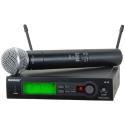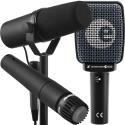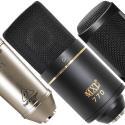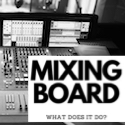How Do Wireless Microphones Work: A Closer Look
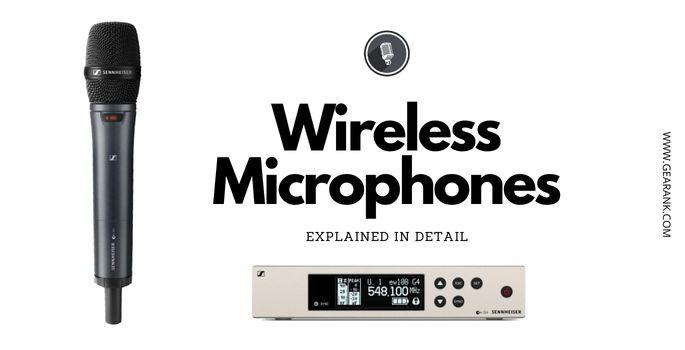
Wireless microphone systems have done a lot in shaping live shows and public speaking events. Aside from being an integral part of music technology, there's so much more to them.
We know these microphones have become so popular because they allow flexibility and freedom of movement. Without them, you wouldn't have controversial stage dives from Kanye West or iconic dance performances from BTS.
But operationally speaking, how do wireless microphones work? For us live sound engineers, it's a realm of expertise we want to explore further.
In this guide, we will go under the hood and examine how wireless microphone systems work. The sections here are heavy on the technical aspect and operations of frequency bands. So stay "tuned." We have a lot to discuss.
Table of Contents
-
Wired vs Wireless Microphones
-
Wireless Microphone System Composition
-
Radio Frequency Transmission of a Wireless Microphone
-
Frequency Coordination in Wireless Mic Systems
-
The Most Common Types of Wireless Microphones
Lastly, I’m will also be providing you a pros and cons list for going wireless and an FAQ section.
How Do Wired Mics Work VS Wireless Mics Work
Wired and wireless microphones work similarly in terms of converting sound waves into electrical signals. Their main components will always include a diaphragm, a coil, and a magnet. Both have the same operating principle--sound waves excite the diaphragm which in turn moves the coil. Then, the magnet converts those movements into electrical signals.
What makes them different is how these signals are transmitted.
A wired microphone transmits audio signals directly to the sound system via a mic cable. These cables transmit the connection to an amplifier, providing a reliable and consistent signal.
Conversely, wireless microphones transmits wireless signals on radio frequencies via a transmitter and receiver.
Wireless Microphone System Composition
Above, we've already examined how the microphone itself works. Now let's elaborate upon the back-end of the wireless system: the transmitter and the receiver.
The Transmitter
A wireless microphone transmitter broadcasts the audio signal to the separate receiver module. An electrical signal from the mic gets converted into a radio frequency (RF) signal.
The transmitter includes a small antenna for sending the radio signal. It also features gain adjustments and frequency selection options. The audio signal is ready for transmission to the receiver once it has been converted into an RF signal.
Not all transmitters are created the same. They come in the form of handheld, bodypack, and plug-in transmitters. Much of the sound quality and dynamic range is affected by the transmitter that you're using.
Handheld mics have built-in transmitters. When you think of wireless mics, you're probably thinking of a handheld microphone transmitter, as they are widely used. A handheld mic usually has the same mic capsule as its wired counterpart, so sound quality should be the same.
On the other hand, bodypack transmitters a designed for hands-free applications. An example of this microphone type is a headset mic or a Lavalier microphone.
The last type of transmitter is the plug-in transmitter. It is commonly used for converting wired XLR mics into wireless mics.
We will further discuss the different types of microphones in the later sections.
The Receiver
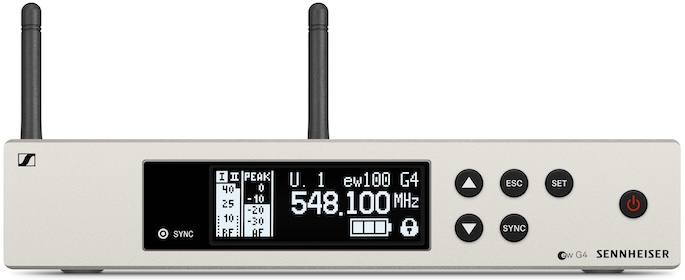
Once the transmitter broadcasts the radio signal, the receiver performs the opposite function. The transmitter and the receiver must be set to the same radio frequency. It decodes the RF signal and converts it back into an audio signal. The audio signal is then sent to the sound system or amplifier for further processing.
How a receiver handles signal strength drops will also depend on the type of receiver you have. You have three main types of receivers in the market. They are non-diversity, diversity, and true diversity receivers.
Non-diversity receivers have one antenna that connects to a transmitter. A receiver of this type is rarely seen in quality wireless microphone systems.
Diversity receivers consist of two antennas, both connected to the same receiver. When the signal strength drops at a certain range on one antenna, the receiver switches to the other.
True diversity receivers would have two antennas, each having its own receiver. True diversity switches based on which antenna can accommodate the signal better. This prevents dropouts from happening. Whereas, in a diversity receiver the signal changes to the other based on signal strength.
Radio Frequency Transmission Of A Wireless Microphone
Frequency modulation and transmission have the same function tuning into radio stations. You have radio stations that have numbers in their brand, such as KIIS-FM 102.7, KBIG 104.3, and WXKS-FM 107.9. These numbers represent the frequency in which you need to be tuned in. The radio station is the sender, and the receiver is the antenna of your car.
Like radio in radio stations, wireless microphones operate in specific frequency bands. The transmitter and the receiver must tune in to the frequency of the other and vice versa.
There are two types of frequency bands in wireless microphone systems VHF (Very High Frequency) and UHF (Ultra High Frequency). These two frequency bands are imperceptible to the human ear. Such a wide range, however, provides more options for frequency assignments.
The frequency range of VHF hovers at 30 Hz-300 MHz.
While UHF is around 300 MHz-3GHz
Interference happens when 2 or more devices are occupying the same frequency range. These ranges are at a very high spectrum and a wide bandwidth. Thus, it's already at a suitable range to prevent interference.
VHF wireless mics have a fixed frequency for each of its microphones. The downside of this mic is that it's easier to set up but susceptible to radio waves in the same frequency band.
Microphones with updated circuitry often operate in the UHD spectrum. It features a lot more flexibility. You can switch from one frequency band to another in cases of other RF devices occupying the same range.
Note that modern digital systems can connect to frequencies similar to where wireless routers and other wireless devices connect to. This can be good or bad, depending on how much crowded the wireless broadband frequencies are at your venue.
Frequency Coordination in Wireless Mic Systems
Frequency coordination is the process of selecting the appropriate frequency bands to prevent interferences from contaminating the signal. One common example of interference is a mobile phone signal when sending a message.
In this process, the possibility of interference from other devices is carefully assessed. Here, you determine if Wi-Fi routers, cell phones, or television broadcast signals are in conflict with your wireless system.
The transmitter and the receiver are set to the same frequency. For setting up a basic wireless system, specific radio frequencies are chosen.
Now, for multiple systems it would require a more meticulous treatment. For complicated cordless microphone setups, proprietary software is used to scan compatible frequencies. Scanning software such as Shure's Wireless Workbench goes through all the frequency bands and assigns your system to their most ideal FM range. Most wireless microphone manufacturers incorporate these types of features for faster and reliable connections.
Devices that operate on or near the same frequency can cause signal degradation. Or worse, even a complete dropout. That's why it's important to assess sources of interference and eliminate those risks.
As a side note, devices with frequency modulation like walkie-talkies, WiFi, radio station towers, and government communications are heavily regulated by the FCC to prevent crossovers and interferences.
These regulations from the FCC have been put in place in place to ensure smooth communication between devices. Currently, the devices we have are assigned to specific frequency band ranges. This is to prevent the phenomenon called broadcast signal intrusion, which intrudes on Broadcast Auxiliary Service.
During the early 90s, there have been cases of people either accidentally or deliberately intercepting radio or TV broadcast signals. The most notable case of signal intrusion was the Max Headroom Incident. It's a fascinating look at how people back then dabbled with radio signals.
Now, back to regular programming.
The Most Common Types of Wireless Microphones
Wireless microphones are either handheld or hands-free and are used for different situations. Handheld, Lavalier, and headset mics are three of the most popular ones in the market.
1. Handheld wireless microphones
The handheld wireless microphone is the most frequently used. The wireless microphone transmitter has a form factor everyone's familiar with. Grippable handles allow performers to hold and control the microphone directly. They feature a microphone capsule integrated into a handheld transmitter. Handheld wireless microphones are suitable for live performances and speeches.
Plug-in transmitters are another alternative that allows you to turn any XLR microphone into a wireless one. Such is the Xvive U3D Stereo XLR Plug-on Wireless System and the Sennheiser XSW-D XLR Base Set.
2. Lavalier microphones
Lavalier microphones, also known as lapel microphones, are small, clip-on microphones that are typically worn on the user's clothing.
These microphones are technically wired microphones that connect to a wireless transmitter. Lavalier mics interface with a bodypack transmitter for a more convenient setup.
Lavalier microphones capture audio just by clipping it onto your clothes. It makes them ideal for situations where the microphone must be hidden from view. It's popular among presenters, public speakers, and broadcast professionals. After all, what these professions require is a hands-free option.
3. Headset microphones
Headset microphones are another hands-free solution. It combines the portability of a Lavalier with a head-worn design. A small microphone capsule at the tip of a wire is attached to a headset frame that wraps around the user's head. Headset mics also use a bodypack transmitter.
You'll often find wireless headset mics in live performers, fitness instructors, and theatrical productions where fixed point to capture audio is required. Lavalier mics in these types of situations tend to lose their efficacy in capturing audio. Headset mics, on the other hand, follow your head movement while the mic is secure in place.
The Main Pros Of Going Wireless
-
Mobility to go around and perform on stage as long as you are within range.
-
No risk of tripping hazards and pulling off because of wire that could potentially damage the mic or the mixer.
-
Very versatile. Excellent for live performances, theater productions, conferences, lectures, and sporting events.
-
Less prone to static noise since long cables aren't required.
The Main Cons Of Going Wireless
-
Wireless microphone systems are more expensive than their corded microphone counterparts.
-
Battery life. Batteries have to be replaced to prevent unexpected power outages from happening. In case of rechargeable batteries, you need to always keep them charged prior to events.
-
Digital wireless microphone systems can be prone to signal dropout and interference. Other radio frequency devices can intercept the signal.
-
Can be complicated to set up. Users must understand frequency coordination, antenna placement, and potential interference sources.
Final Thoughts
How do wireless microphones work? The wired and wireless microphones work the same way in terms of how they process electrical audio signals. In terms of broadcasting the frequencies a wireless microphone system has a transmitter and a wireless receiver.
We know that the frequency in which wireless microphone systems operate is either VHF or UHF. They're set to those frequency bands because a wider bandwidth allows more options.
Frequently Asked Questions
What is the average range of a wireless microphone system?
The transmission range of wireless microphones can vary widely from brand to brand. Several factors can also affect the range. This could include the environment, obstacles, or other sources of interference. If we tally all of these factors, 100 to 1000 feet is a safe estimate. Distance and interference can negatively impact signal quality.
Can you use multiple transmitters with a single receiver?
Yes. Wireless microphone receivers can be assigned to multiple wireless mic transmitters. Some receivers are brand-specific, while others are interoperable regardless of brand. However, the audio quality of different mic brands assigned to an interoperable receiver might vary.
Transmitters, of course, have to be configured to the same frequency range as the receiver. Assigning the right frequency range prevents interferences from occurring.
Do wireless microphones need batteries or external power sources?
The wireless microphones are battery-powered. Whereas, receivers may use either AC adapters or batteries. Batteries for both wireless mics are 9-volt batteries lasting around 8-12 hours, depending on use. It's important to replace any batteries regularly before the show.
Analog System Vs. Digital Wireless Systems
The main difference is in how they convert audio signals. Analog wireless systems compress audio signals, transfer the analog signal as a modulated radio wave, and expand them again at the receiver. While digital wireless mics convert the audio into a digital signal instead.
Here are some of the differences between a wireless analog and digital system:
- Latency - Latency, or delay, differs between analog and digital systems. Analog signals has almost zero latency, while digital wireless systems can vary.
- Audio Quality - Analog systems compress and uncompress the audio signal. In telecommunications, this is called "companding." This can reduce sound quality, especially with cheaper analog systems. Digital wireless mics offer companding free audio transmission.
- Radio Frequency Performance - Analog and digital systems operate in the UHF band range. However, digital microphones work more efficiently in this space.
- This does heavily depend on the range you are working in. Many have automatic frequency selection.
Contributors:
- Allen Articulo - Co-writer
- Jerry Borillo - Illustrator



